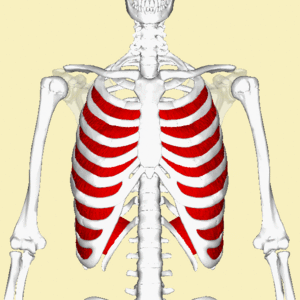Intercostal muscle facts for kids
The intercostal muscles are a group of muscles found between your ribs. Think of them as helpers for your breathing. These muscles work together to make your chest bigger or smaller, which helps you take air in and push it out.
When you breathe in, a big muscle called the diaphragm tightens and moves down. At the same time, some of your intercostal muscles pull your ribcage up and out. This makes more space inside your chest, allowing your lungs to fill with air.
When you breathe out, especially if you're pushing air out (like when you sigh or blow out a candle), other intercostal muscles help make your chest smaller, pushing the air out of your lungs.
Types of Intercostal Muscles
There are three main types of intercostal muscles, each with a special job:
- External intercostal muscles: These muscles are on the outside. They help you breathe in. They pull your ribs up and slightly open, making your chest wider. This helps your lungs take in more air.
- Internal intercostal muscles: These muscles are deeper inside. They help you breathe out strongly. When you need to push air out, these muscles pull your ribs down and inward. This makes your chest smaller and helps push the air out.
- Innermost intercostal muscles: These are the deepest layer of muscles. They also help to make your chest smaller, so they assist with breathing out, similar to the internal intercostal muscles.
These muscles are super important because they work with your diaphragm to make sure you can breathe easily all the time, whether you're running or just relaxing!
See also
 In Spanish: Músculos intercostales para niños
In Spanish: Músculos intercostales para niños


